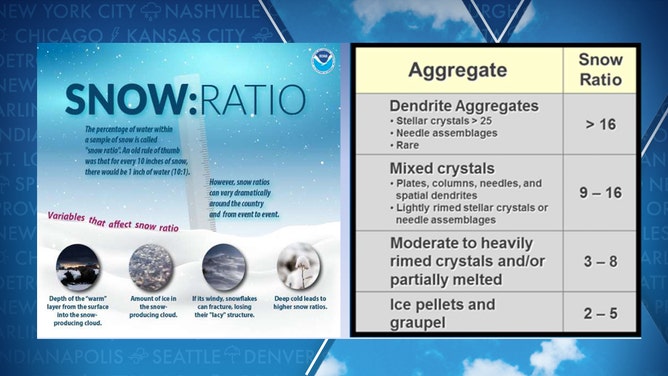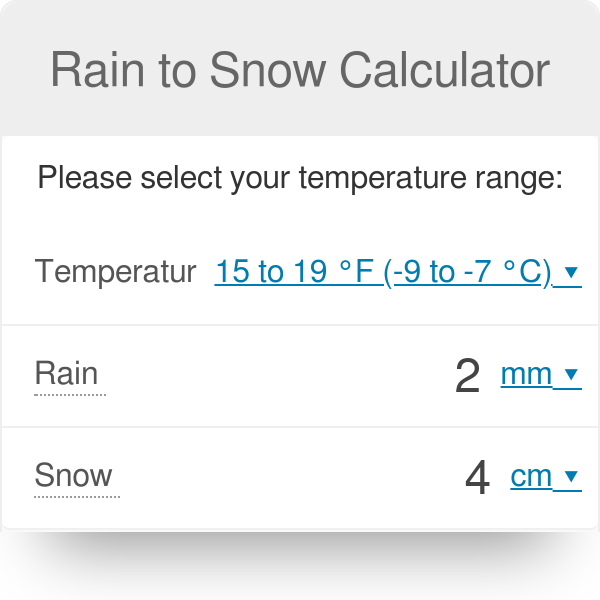6 Inches of Snow Equals How Much Rain
A conversion chart that converts snowfall depths and amounts to the water equivalent. The 10-to-1 ratio is the assumption that for every 10 inches of snow that falls there is roughly 1 inch of actual moisture.

How Much Snow Will An Inch Of Rain Produce
More densely packed and wet snow is in the ratio of 8 inches of snow to 1 inch of equivalent rainfall and more powdery snow is about 14 to 1 ratio.

. The NWS uses calculations each year in specific areas where the density ratio may be slightly different to approximate how much water will be returned to the natural rivers lakes. As such 1 inch of rainfall equates to around 10 inches of snowfall. Ten inches of fresh snow can contain as little as 010 inches of water and as much as 4 inches of water depending on crystal structure wind speed temperature and other factors.
A typical ratio for our area is 10 inches of snow per inch of water but when the snow is wet or mixes with freezing rain or sleet at times. We had 175 inches of liquid equivalent yet ended up with 232 inches of snow not 175 inches of accumulation. This ratio will fluctuate depending on the temperature and windchill.
So over a period of a little over 48 hours I measured 93 inches and. Intuitively this is the number of inches of snow on your roof in the place where the cover is the thickest. The majority of US.
Answer This varies depending on the type of snow but to make 1 inch of water rain you need 10 inches of average snow 4 to 5 inches of wet snow or 15 inches of powdery snow. However the lower levels of the atmosphere had warmed some so the snow was denser. Issued when a combination of hazardous winter weather in the form of heavy snow heavy freezing rain or heavy sleet is imminent or occurring.
In dense snowfall the molecules are tightly compressed. If there is more super cooled water droplets in the cloud snow ratios will be lower. S R 5 T16.
If youre not sure which type to choose always settle for the wetter types as they are denser. The warmer it is closer to freezing the lower the ratio will be. Measure by pouring the melted snow into the graduated rain tube and get a direct measure of the water content.
For example a dry powdery snow is likely to have a 201 or 301 ratiothat is 20 or 30 inches of snow would be equal to 1 inch of rain. During that storm the snow ratio was closer to 15 inches of snow to one inch of rain. This ratio is actually only an estimate and is based on snow forming in the 28-34 degrees F range.
Heavy wet snow has a very high. The density of snow depends on whether its fresh wet wind-packed or mixed with ice. For example an inch of rain may result in only six inches.
Hourly Always immediately after the snow ends Snow Depth Once per day at 1200 UTC Snowfall Water Content Once per day at 1200 UTC 8-inch gauge or 0000 UTC 4-inch gauge. No need to melt the snow. In such situations the rain-to-snow ratio will be 18.
Thats quite a difference. According to the majority of weather services the average level of snow is 10 times that of rainfall. Snows fall with a water-to-snow ratio of between 004 and 010 Response last updated by CmdrK on Jul 09 2021.
A heavy wet snow on the other hand could have a. Of course the actual amount can vary considerably depending on whether the snow is heavy and wet or powdery and dry so this is based on the average water content of snow. The water content of snow is more variable than most people realize.
Ten inches of fresh snow can contain as little as 010 inches of water. The following formula is used to calculate the amount of snow in inches from the rain in inches. Another 08 inch of snow on Sunday night melted to 006 inch water for a snow to water ratio of 1331.
If temperatures are colder say in the 10-15 degree F range estimates can be as high as 30-to-1 30 inches of snow. Answer 1 of 3. Where S is the amount of snow inches R is the amount of rain inches T is the temperature.
While many snows that fall at temperatures close to 32 o F and snows accompanied by strong winds do contain approximately one inch of water per ten inches of snowfall the ratio is not generally accurate. Amount of ice in the snow producing cloud. Winter Storm Warnings are usually issued 12 to 24 hours before the event is expected to begin.
That snow melted down to 028 inch of water for a snow to water ratio of 611. Or calculate the water content with the depth of the snow in the tube and the ambient temperature. When to Measure Snowfall At least every 6 hours more frequently if it may melt eg.
Rain to Snow Formula. That depends on the air temperature and how much moisture there is available. Obviously this is an approximation but a good one.
Issued 12-48 hours in advance of the onset of severe winter. How much snow does it take to equal an inch of rain. Depth of the warm layer from the surface into the snow producing cloud.
But the rain-to-snow ratio in any particular snowstorm varies widely depending on local weather conditions which include many factors. If there is a higher amount of ice crystals snow ratios will be higher. Using a rule of thumb that each 10 inches of snow if melted would produce one inch of water then each inch of snow produces about 2715 gallons of water per acre.
Or weigh the snow.

How Do We Measure Snow Tree House Weather Kids University Of Illinois Extension

No comments for "6 Inches of Snow Equals How Much Rain"
Post a Comment